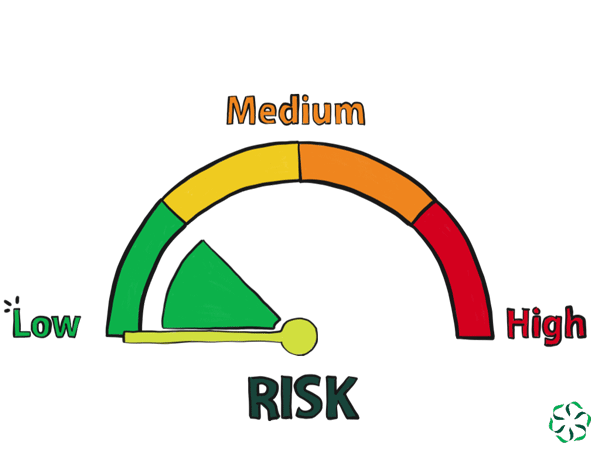In this post, we’ll explore the differences between hazard, exposure, and risk so you can make better, informed decisions around ingredient safety.
What is a hazard?
Hazards, in terms of ingredient safety, are any ingredient or process that we know can cause harm.
For example, we know that water can harm humans in many situations, such as over-consumption or drowning. Hazards remain static, meaning they are not actively causing harm unless we engage with the hazard. This concept shows us that water remains a hazard whether it’s in a glass, on our table, a pond in our backyard, or locked in a maximum-security vault.
The hazard does not change.
What is exposure?
We know that there are many hazards in foods around us such as cyanogenic glycosides, a compound that upon digestion can break down into cyanide, in fruit seeds and pits or even nitrates and nitrites in large enough quantities. Importantly, we don’t hear stories of people getting critically ill from consuming a rogue apple seed or eating hotdogs at a cookout.
We need to be exposed to hazards and at high enough quantities to be impacted by a hazard.
For example, if we eat an apple, we are exposed to apple seeds. The potential is there for us to eat some of those seeds, but most of us do not. Science also tells us that we would need to consume at least 200 apple seeds in a short amount of time before we’d get ill.
Exposure represents the action of engaging with a hazard. The actions we take around hazards determine our exposure. For foods and ingredients, it means understanding how much of something we can safely consume. The U.S. FDA and the USDA work with scientists and toxicologists to ensure the ingredients in our foods do not harm us. Their goal is to ensure that what we would typically consume in a day, week, month, year, decade, or even over a lifetime will not harm us due to repeated exposure. That means the ingredients in our foods are regulated to ensure food manufacturers only use the ingredients in safe amounts.
Because we know that there can be instances when some people may be more sensitive to the adverse effects to certain ingredients than others or that there may be some limitations to the scientific information about a specific ingredient, the FDA remains conservative with their approximations to ensure we do not fall ill. That also means the FDA may decide to reevaluate ingredients if new research becomes available.
How do we calculate risk?
Risk is calculated using the formula: hazard X exposure = risk.
The formula allows us to take hazard and exposure into consideration so we can determine risk. Once we’ve established risk, we can then identify the safe levels for consuming an ingredient.
Going back to our apple seed example, we know that due to the chemical composition, apple seeds are a hazard. We also know that one would need to chew and consume at least 200 apple seeds in a short amount of time before beginning to have a negative health impact.
Let’s look at the formula with hotdogs. We know that in large enough quantities and over high heat nitrites can become harmful to human health, but we must take into consideration how frequently we consume hotdogs. We know hotdogs are mostly consumed during summer months rather than frequently throughout the year, so we can determine that there is a low risk of having adverse health impacts due to the nitrates in hotdogs.
How can we use risk to make informed decisions?
Understanding risk allows us to make informed decisions. We can weigh the risk against the benefits.
Let’s apply the decision-making process to our examples. We know that it takes at least 200 chewed apple seeds to have a negative health impact. We also know that apples are full of nutritious ingredients including fiber and Vitamin C, which makes them an excellent, healthful snack. We can determine that the benefits of eating the apple far exceed any minuscule risk associated with apple seeds.
Looking at hotdogs, we know the risk of long-term adverse health impacts is very low when consumed in moderation. We know that removing the nitrate and nitrates preservatives would greatly increase the likelihood of harmful bacteria, to grow. We know that illness-related to food-borne bacteria are severe and even fatal. The benefits of safe hot dogs clearly outweigh the risk of consuming preservative-free hotdogs.
We can look at risk from the perspective of water. We know we must have water to live, but we also know that drinking too much water can cause harm. The risk is worth the benefit.
With water, we can go one step further. Many people like to swim and enjoy going to pools. We know people can drown in pools. Before we go swimming, we must decide if it’s worth the risk. We know that water is a hazard. We know that going swimming exposes us to the hazard. But, at this pool, there is a lifeguard on duty, and we know how to swim. The health and entertainment benefits of swimming outweigh the hazard we’d be exposed to.
What does this mean for us?
Understanding hazard, exposure, and risk allow us to make better decisions. It will enable us to accurately weigh the pros and cons of an ingredient, or any situation so that we can make rational decisions based on the facts.
If you have any questions about ingredients or ideas for a blog post, please send us an email or submit your idea to us at go.msu.edu/cris-idea.

